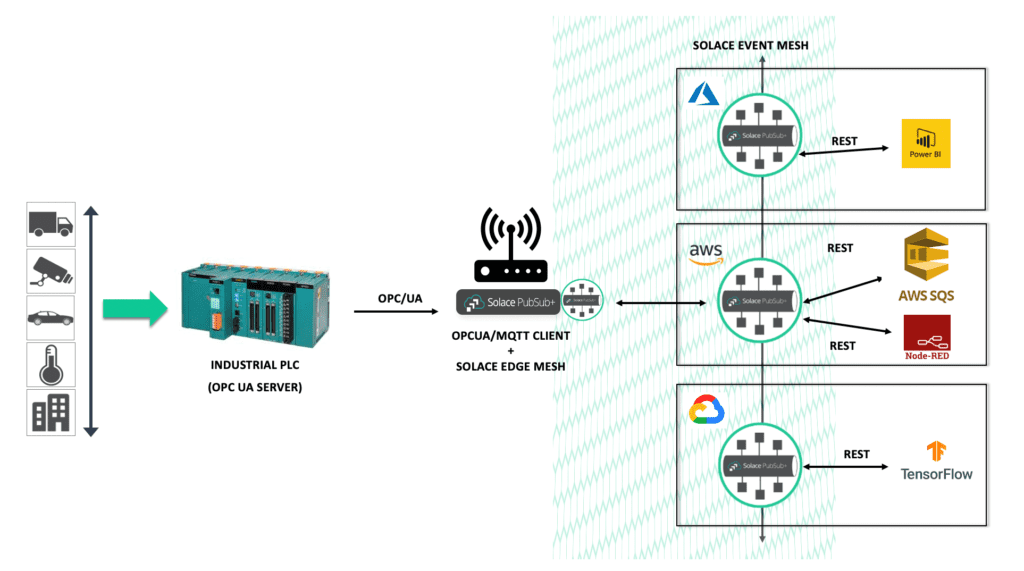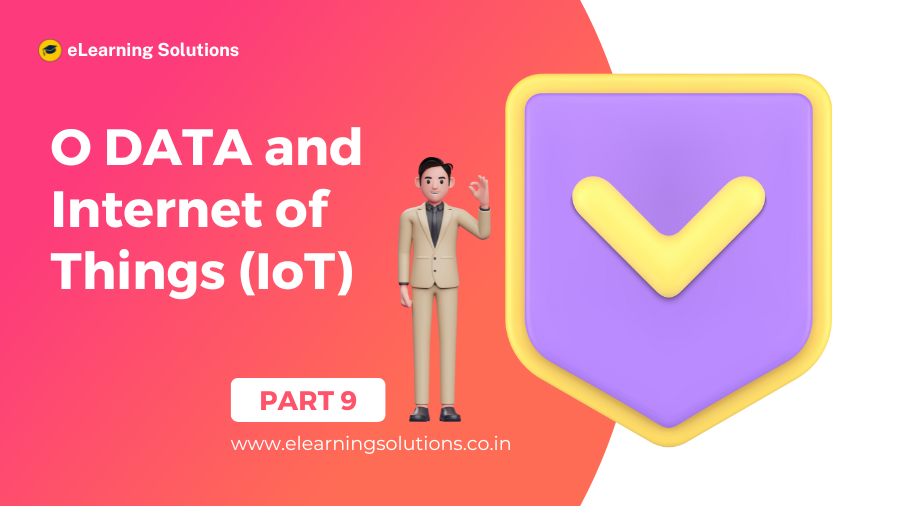Introduction to O DATA and Internet of Things (IoT)
The fusion of O DATA and the Internet of Things (IoT) has ushered in a new era of connected devices and data management. O DATA, the Open Data Protocol, provides a standardized way to build Web APIs for data exchange, while IoT enables seamless connectivity and communication between various smart devices and systems. This article delves into the exciting realm of O DATA and IoT, exploring how they work together to revolutionize data management and IoT integration.

Unified Data Access and Management
O DATA plays a pivotal role in IoT data management by offering a unified and standardized approach to access and interact with IoT-generated data. With O DATA’s consistent API design and query capabilities, developers can effortlessly retrieve data from diverse IoT devices and sensors. This uniformity streamlines the integration process and facilitates the seamless exchange of information between IoT devices and backend systems.
Entity Modeling for IoT Data
In an IoT ecosystem, various devices and sensors produce a vast array of data streams. O DATA’s entity modeling allows developers to represent these data streams as entity sets, making it easier to manage and manipulate them. Each entity set represents a collection of related data, enabling developers to organize, filter, and query IoT data effectively.
Metadata and Data Descriptions
O DATA’s support for metadata and data descriptions is valuable in an Internet of Things context. Metadata provides information about the structure and type of data, enhancing the interpretability of Internet of Things data. It enables applications to understand the data format, aiding in data transformation and integration processes. By leveraging metadata, Internet of Things data becomes more self-descriptive and easier to work with.
2. Real-time Data Streaming with O DATA

Enabling Real-time Data Access
Internet of Things environments often require real-time access to data to support timely decision-making and quick responses to events. O DATA’s support for real-time data streaming facilitates immediate access to IoT-generated data. Clients can subscribe to data streams and receive updates as soon as new data is available, ensuring that they are always up-to-date with the latest information.
Data Change Notifications
O DATA supports data change notifications, allowing clients to receive notifications when specific data entities are modified. In an Internet of Things setting, this feature is invaluable for monitoring critical data points. For instance, in a smart home system, the Internet of Things hub can notify the client application when the temperature exceeds a predefined threshold, enabling proactive actions like adjusting the thermostat.
Asynchronous Data Processing
In Internet of Things scenarios, data processing can be resource-intensive and time-consuming. O DATA’s support for asynchronous data processing enables clients to submit long-running tasks to the server and receive notifications when the task is completed. This capability optimizes system performance and responsiveness in Internet of Things applications that involve complex data operations.
3. IoT Integration Examples
Smart Home Automation

One of the most common Internet of Things integration examples is smart home automation. O DATA enables seamless integration of various smart devices, such as thermostats, lighting systems, and security cameras, with the central smart home platform. Through O DATA APIs, the smart home platform can access and control the devices, allowing users to manage their home environment remotely.
Industrial IoT (IIoT)

In the industrial domain, O DATA integration is instrumental in Industrial IoT (IIoT) applications. IIoT involves a network of interconnected sensors, machines, and systems that generate real-time data. O DATA allows businesses to access and analyze this data in a standardized manner, facilitating efficient decision-making, predictive maintenance, and process optimization.
Smart City Solutions
Smart cities leverage IoT technologies to enhance urban living, improve resource management, and optimize city services. O DATA provides a unified approach to integrate diverse Internet of Things devices and systems deployed across the city. This integration empowers city administrators to gather real-time data, monitor infrastructure, and optimize traffic flow, leading to more sustainable and responsive urban environments.
Conclusion
The convergence of O DATA and the Internet of Things is reshaping the way we interact with data and IoT devices. O DATA’s standardized API design, real-time data streaming, and IoT integration capabilities make it an indispensable tool for managing and leveraging IoT-generated data. As Internet of Things continues to expand its influence across various industries, O DATA will remain a key enabler of seamless data exchange, powering the smart and connected world of tomorrow.
FAQs (Frequently Asked Questions)
-
-
- Can O DATA handle large volumes of real-time data from IoT devices? Yes, O DATA can handle real-time data streams from Internet of Things devices efficiently. Its support for real-time data streaming and asynchronous data processing allows it to manage large volumes of data in real-time.
-
- What role does O DATA play in IoT data security? O DATA’s standardized API design and authentication mechanisms contribute to IoT data security. By adhering to O DATA best practices for security and authorization, developers can ensure secure data exchange between Internet of Things devices and backend systems.
-
- Can O DATA be used with both cloud-based and edge-based IoT deployments? Yes, O DATA is versatile and can be used with both cloud-based and edge-based Internet of Things deployments. Its flexible design allows it to adapt to different Internet of Things architectures and scenarios.
Bonus: Enterprise Resource Planning(ERP) Unlocking Business Efficiency
PART-8
PART-10
Interested in this SAP Classes ? Fill Your Details Here
Find Your Preferred Courses
SAP SD (Sales and Distribution) is a module in the SAP ERP (Enterprise Resource Planning) system that handles all aspects of sales and distribution processes. S4 HANA is the latest version of SAP’s ERP suite, built on the SAP HANA in-memory database platform. It provides real-time data processing capabilities, improved…
SAP Human Capital Management (SAP HCM) is an important module in SAP. It is also known as SAP Human Resource Management System (SAP HRMS) or SAP Human Resource (HR). SAP HR software allows you to automate record-keeping processes. It is an ideal framework for the HR department to take advantage…
I am text block. Click edit button to change this text. Lorem ipsum dolor sit amet, consectetur adipiscing elit. Ut elit tellus, luctus nec ullamcorper mattis, pulvinar dapibus leo.
Salesforce Developer Training Overview Salesforce Developer training advances your skills and knowledge in building custom applications on the Salesforce platform using the programming capabilities of Apex code and the Visualforce UI framework. It covers all the fundamentals of application development through real-time projects and utilizes cases to help you clear…
SAP EWM stands for Extended Warehouse Management. It is a best-of-breed WMS Warehouse Management System product offered by SAP. It was first released in 2007 as a part of SAP SCM meaning Supply Chain Management suite, but in subsequent releases, it was offered as a stand-alone product. The latest version…
Oracle PL-SQL is actually the number one database. The demand in market is growing equally with the value of the database. It has become necessary for the Oracle PL-SQL certification to get the right job. eLearning Solutions is one of the renowned institutes for Oracle PL-SQL in Pune. We believe…
Course details for Pega Training in Pune Elearning solution is the best PEGA training institute in Pune. PEGA is one of the Business Process Management tool (BPM), its development is based on Java and OOP concepts. The PAGA technology is mainly used to improve business purposes and cost reduction. PEGA…
SAP PP Training Institute in Pune SAP PP training (Production Planning) is one of the largest functional modules in SAP. This module mainly deals with the production process like capacity planning, Master production scheduling, Material requirement planning shop floor, etc. The PP module of SAP takes care of the Master…
SAP BASIS Module Course Content (1) Hardware and Software Introduction (i) Hardware (a) Hardware Introduction (b) Architecture of different Hardware devices (ii) Software (a) Software Introduction (b) Languages and Software Development (c) Introduction to OS (d) Types of OS (iii) Database Concepts (a) Introduction (b) Database Architecture and concepts (c)…
Curriculum Details SAP HANA Administration SAP HANA Introduction SAP HANA Introduction SAP HANA Information Sources Installation Preparation SAP HANA Sizing Linux Operating system requirements SAP HANA Installation Introduction to SAP HANA Lifecycle Management tools Describing Advanced Installation options Explaining a Distributed system SAP HANA Architecture SAP HANA Architecture and Technology…
Business Warehouse (BW) is SAP’s data warehousing application; it uses an SAP NetWeaver application server, but can run on many different databases. Improvements come with each version of Courses for sap BW on HANA training, but a really big jump in functionality comes when SAP BW is installed on the…
SAP SAP HANA simple logistics is also known as HANA enterprise management. Different area of business is combined in this suit itself like HANA enterprise-management helps in faster and efficient processing of business data in the area of logistics, supply chain, procurement, user experience, sales, partner management. So Course for…
ABAP remains a key language as many SAP business applications and custom developments are written in ABAP, with Courses for sap ABAP on HANA training there are numerous improvements. The ABAP language, which allows writing streamlined ABAP code and benefit from SAP HANA. SAP HANA is a relational DBMS in SAP…
SAP HANA is the latest ERP Solution from SAP, which is a combination of Hardware and Software. HANA has unprecedented adoption by the SAP customers. courses for SAP HANA training institutes. SAP HANA is the latest, in-memory database, and platform which can be deployed on-premises or cloud. SAP HANA is a…
Oracle Applications R12 HRMS is one of the most demanded applications by most organizations. It is the core application possess by the ERP system. The core objective of the organization to implement Oracle R12 HRMS is to organize the entire activates of human resources management. An Elearning solution is well…
Elearning solutions provide training suit for Oracle Apps R12 SCM with training from industry experts. The organizations are adopting Oracle’s supply chain management cloud as they deliver the insights, visibility, and capabilities for organizations’ management. Oracle Apps R12 SCM allows the industry to create own intelligent supply chain. Hence, it…
Oracle Apps R12 Technical Course Elearning solutions is the best Oracle Apps R12 technical course in Pune owned by well trained and certified trainers. The training is conducted by the best experienced IT professionals with skilled resources. The course structure is based on the real-time scenario so that it will…

₹25,000.00
Elearning solutions is the best SAP FICO training institute in Pune. SAP FICO is the Finance and Cost controlling module is one of the most important and widely used SAP ERP modules among organizations. As it is very robust and encounter almost all the business processes. In SAP FICO, FI…
Elearning solutions provide SAP SD training. The tutorials are designed for the students who desired to understand SAP SD concepts and implement them in practice. The SAP SD training is delivered by industry experts, who are aware of the real-time scenarios. Hence, supporting students understand, what will be there on…
SAP WM training is offered by Elearning solutions provides 100% hands-on practical classes. The primary focus of training is getting placement for all the students. The tutorials are designed for the students who wished to work on live projects for the organizations. The syllabus of SAP WM training is crafted…
Elearning solutions are the best SAP MM training institute in Pune. SAP MM (material management system) is one of the important models of the SAP ERP system, which is particularly designed for business processes. SAP MM deals with the entire material and inventory management of the organization. The module is…
Elearning Solutions best SAP ABAP training institute in Pune provides real-time training for students. SAP ABAP (Advanced Business Application Programming) is a programming language for building SAP applications such as SAP R/3 which runs in the SAP ABAP runtime environment. (SAP ABAP online course) SAP ABAP is used by organizations…








 WhatsApp us
WhatsApp us